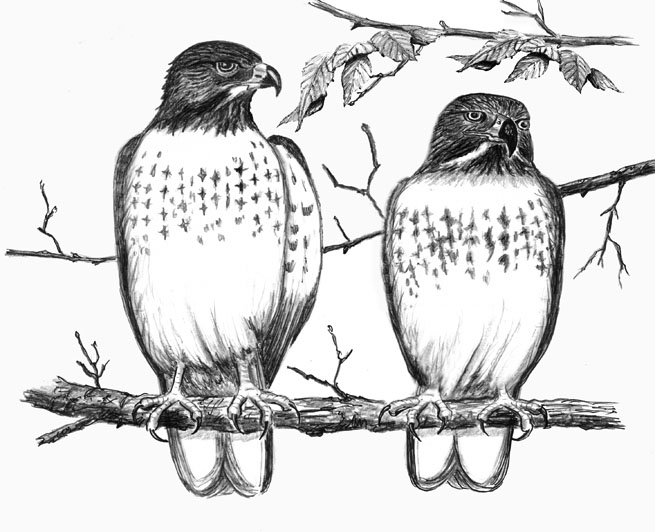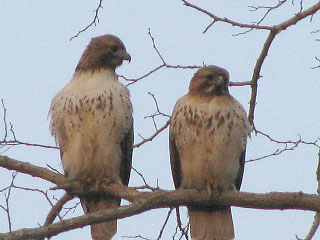
Dear Bird Folks,
My husband and I saw these two hawks (see attached photo) sitting on the branch of a tree near our house this morning. Can you tell us what kind of hawks they are? Also, why are they sitting so close together? Thank you.
– Catherine, Orleans, MA

They’re in love, Catherine,
That’s why they are sitting so close together. Look at them. Isn’t it obvious? Even hawks have feelings. Once you get past the deadly talons and the flesh-tearing beaks, you can clearly see that the two birds have the look of love in their eyes. And while neither bird is saying anything, the male’s body language is sending an unmistakable message to the female. He’s saying that he would gladly rip the heads off a dozen rabbits just to make her happy. Whoa! Talk about romantic. If those tender, poetic words don’t fill your heart with warmth, you have ice water in your veins.
The reason I know they are in love is because it’s spring. This time of year all the birds are in love…well, a bird’s version of love. Plus, they are sitting together. Hawks rarely tolerate each other’s company, unless they happen to be a couple. Your two birds are Red-tailed Hawks. The ever-thoughtful Red-tails are one of the few birds of prey that have obvious field marks. This makes it possible for even casual birders to be able to identify them. The other thing red-tails have going for them is they are ubiquitous. They can be found in just about every type of habitat and in every state, except for Hawaii. Red-tails hate pineapples.
The definitive feature of the Red-tailed Hawk is, of course, its red tail. It’s nice when a bird’s name helps with identification, unlike the Herring Gull, which looks nothing like a herring or the titmouse, which doesn’t look at all like a…never mind. When seeing this hawk from the back, the bright red tail stands out. However, if you see the bird head-on (like in the photo you sent) the tail coloring is washed out and less obvious. In this case you have to use other clues for identification. First, notice the bird’s body shape. The red-tail is a robust, stocky bird, looking like a beer keg with a head. And speaking of head, the head is often dark, almost hooded and is in sharp contrast to the chest, which is usually light-colored. However (are you still following this?), the most important feature to look for when seeing a red-tail from the front is the so-called “bellyband.” Red-tails typically have a band of dark feathering running across their lighter chest, but the band is not solid, like that on a Killdeer or a bumblebee. This band is made of large, dark speckles, making the bird look like my shirt after I eat a bowl of lentil soup.
(Note: All of these field marks pertain to typical Red-tailed Hawks found in the Northeast. The trouble is the plumages aren’t consistent throughout the birds’ range. Red-tails tend to be darker in the western half of the continent, which can make identification frustrating. We won’t get into that right now. It’s tax season and we don’t need any more frustration.)
Spring is a fun time to watch red-tails. They are extremely active and very noisy, regularly giving their classic hawk scream. On any calm, sunny day red-tails may be seen soaring high over their territories. Look for them above an open area. I like to watch them soar high over the highway while I’m driving. (Watching the road is so boring.) What I really like about red-tails is that they don’t get up early. They let the robins, cardinals and all of the other idiot songbirds sing their heads off at the crack of dawn. Hawks wait for a more civilized hour to start their day. After the morning sun has heated things up a bit, thermals of warm air begin to drift upwards. The hawks use these thermals to soar upon. From high above their territory they watch for other hawks that may be intruding. If an encroaching hawk is spotted, the resident hawk usually dives at it with its talons fully extended. After a scuffle or two the new hawk moves on, but not before suggesting that the attacking hawk get some serious anger management counseling.
Sometimes fighting Red-tailed Hawks aren’t adversaries, but are in fact partners. The courtship behavior of red-tails includes similar aerial battles. Fighting high above the ground with long, extended talons may not seem very romantic to us, but it works for the hawks. It works so well that the two birds typically mate for life. (That’s good advice for anyone looking for a life-long mate; simply let your fingernails grow.)
In a perfect world hawk couples would use the same nest over and over each year. However, sometimes they come home to find that Great Horned Owls have moved into their nest. When that happens the hawks have to search for a new place to nest. There is no negotiating with Great Horned Owls.
Thanks for the photo, Catherine. It’s a classic pic of a Red-tail Hawk couple. It clearly shows their stocky bodies, the dark heads, the light chests and the speckled bellybands. We can also distinguish the smaller male from the larger female. The female is the bird on the left. With hawks, the female is typically bigger, heavier and more muscular, but I’m not going to be the one to tell her that.